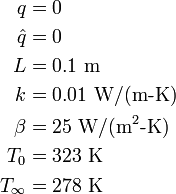Nonlinear finite elements/Homework 2
< Nonlinear finite elementsProblem 1: Classification of PDEs
Two commonly encountered PDEs in engineering are
and
- What physical processes do the two PDEs model?
- Write out the PDEs in elementary partial differential notation (that is, using symbols of the form
 ).
). - Determine whether the PDEs are elliptic, hyperbolic, or parabolic. Show how you arrived at your classification.
Problem 2: Models of Physical Problems
The differential equation which can be written as
arises in a number of fields of physics and engineering.
Write out the ODEs for at least five of these physical situations and identify the meanings of the variables.
Problem 3: Weighted Residual Methods
Give examples from the scientific literature, with full references, where the collocation, subdomain, and least squares weighted residual methods have been used.
Explain why the standard finite element method has not been used in these examples.
One example for each method will suffice.
Problem 4: Least Squares Method
The residual over an element (for the general second-order ODE) is defined as
where
In the least squares method, the residual  is minimized in the following sense:
is minimized in the following sense:
- What is the weighting function used in the least squares approach?
- Develop a least-squares finite element model for the problem. You don't have to find the solution to a specific problem - just the components of
 ,
,  , and
, and  for an element will do.
for an element will do. - Discuss some functions (
 ) that can be used to approximate
) that can be used to approximate  .
.
Problem 5: Heat Transfer
The differential equation that is used to model one-dimensional heat transfer is
where  is the temperature,
is the temperature,  is the thermal conductivity, and
is the thermal conductivity, and  is the heat generation.
is the heat generation.
Let us assume that the boundary conditions are
where  is a prescribed temperature,
is a prescribed temperature,  is a convective heat transfer coefficient,
is a convective heat transfer coefficient,  is the ambient temperature, and
is the ambient temperature, and  is a prescribed heat flux.
is a prescribed heat flux.
- Formulate the finite element model for this problem over one element, that is, find expressions for the stiffness matrix and the load vector.
- Use ANSYS (or any other software tool) to solve the problem of heat conduction in an insulated rod. Compare your solution with the exact solution (if available). Try at least three refinements of the mesh to confirm that your solution converges.
- Write your own code to solve the problem in part 2 (use two elements). Compare your solution with the ANSYS (or other software) solution.
Use the following data:
You can look at the 1-D heat conduction problem on the Introduction to Ansys page to see how ANSYS deals with heat conduction.





![\frac{\partial }{\partial c_i}\int_{x_a}^{x_b} [R^e(x,c^e_1,c^e_2,\dots,c^e_n)]^2~dx = 0,
\qquad i=1,2,\dots,n ~.](../I/m/7de629d08aef872c89d3e2f67265129c.png)

![\begin{align}
T(0) &= T_0 \\
\left.\left[ k\cfrac{dT}{dx}+\beta~(T - T_{\infty})+\hat{q}\right]
\right|_{x=L} & = 0
\end{align}](../I/m/87ec87222dc24294389a695f9fe2bfca.png)
